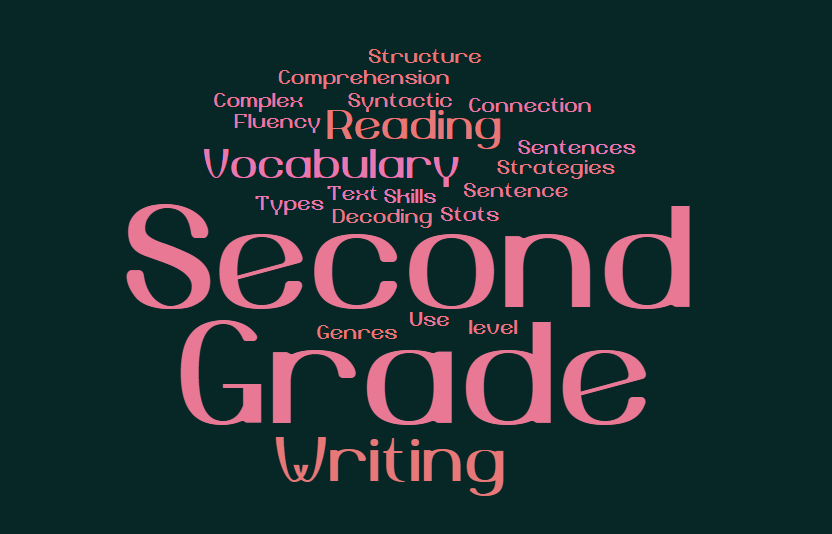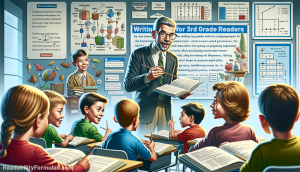 A second-grade reading level refers to the literacy skills of a child in the second grade, age 7-8. This stage of reading is marked by growing fluency and comprehension skills. “Syntactics” refers to the arrangement and order of words in sentences, essentially focusing on sentence structure.
A second-grade reading level refers to the literacy skills of a child in the second grade, age 7-8. This stage of reading is marked by growing fluency and comprehension skills. “Syntactics” refers to the arrangement and order of words in sentences, essentially focusing on sentence structure.
Here’s the profile of 2nd grade readers:
- Vocabulary and Decoding Skills: Children in second grade often recognize and understand hundreds of words. They decode many words phonetically and begin to recognize more sight words.
- Reading Fluency: They can read more smoothly and with better expression. They read aloud with appropriate inflection and pace and recognize common words without sounding them out.
- Comprehension: Second-grade children understand and remember what they read. They answer basic questions, identify the main idea, recall specific details, and start to make simple inferences and predictions.
- Complex Sentences: They can read and understand more complex sentences and grasp basic grammatical concepts.
- Genres and Text Types: Teachers expose second graders to different text types, including fiction, non-fiction, poetry, and informational texts. They encourage them to explore different genres and authors.
- Use of Strategies: Teachers instruct second graders to use specific reading strategies like re-reading, looking for context clues, and using pictures or diagrams.
- Writing Connection: Many curriculums require second graders to write responses to what they read, make connections to their own lives, or write short narratives.
- Moral and Theme Understanding: Second graders understand simple morals or themes in stories and relate them to their own lives.
Texts suitable for second graders advance in complexity from those of first graders, but they still maintain certain structural guidelines to develop their reading skills.
- Sentence Structure: While there’s a continued focus on subject-verb-object (SVO) patterns, second graders start seeing more varied structures, including compound sentences using conjunctions like “and,” “but,” and “so.” Around 70% may follow the simple SVO pattern, with 30% introducing compound structures.
- Vocabulary: Vocabulary expands to include less common words, multisyllabic words, and more descriptive language, including basic adjectives and adverbs. Common and easily decodable words comprise 85% of the vocabulary, with 15% being more complex or specialized.
- Tenses: Students explore present, past, and future tenses, with an emphasis on regular past tense verbs and some common irregular verbs. Present tense appears in 60% of sentences, past tense in 30%, and future tense in 10%.
- Punctuation: Basic punctuation appears in 100% of sentences, while complex punctuation like commas in lists or quotation marks appear in 20-30%.
- Paragraphs: Texts have multiple paragraphs, each focusing on a distinct idea or topic. Transition words like “next,” “then,” or “after” are introduced. Around 90% of texts feature multiple paragraphs with distinct ideas. Paragraphs contain 3 to 5 sentences. Shorter paragraphs help maintain engagement and comprehension.
- Repetition: While repetition still aids comprehension and thematic understanding, it’s less pronounced than in first-grade texts.
- Contractions: A broader range of contractions appears, such as “won’t,” “can’t,” and “haven’t.” Contractions appear in 20% of sentences.
- Complexity: Occasional use of passive voice or more complex syntactic structures, but in limited and contextual ways. Passive voice or complex structures appear in 5-10% of sentences.
- Questions: Along with yes/no and “wh-” questions, texts include more inferential questions to foster comprehension and thinking. About 15% of the text consists of or includes questions.
- Dialogues: Dialogues become more complex, introducing characters’ emotions or intentions.
- Compound Words and Prefixes/Suffixes: Used to expand vocabulary and morphological understanding. Around 15% of the vocabulary include compound words or words with prefixes/suffixes.
- Descriptive Language: Texts contain more descriptors, aiding in visualization and comprehension. Approximately 25% contain more descriptive language to aid visualization and comprehension.
SENTENCE LENGTH
Using different sentence lengths helps support these readers as they develop fluency and comprehension skills, without overwhelming them with complexity. Approx. 80-90% of sentences may fall within the 6 to 12-word range.
- Short Sentences (4-6 words): a 2nd-grade texts contain 25-30% of short sentences to maintain clarity and reinforce key concepts.
- Medium Sentences (7-10 words) | 50-60%: Medium-length sentences allow for more complexity and detail, introducing compound subjects or objects, and simple conjunctions.
- Long Sentences (11-12 words or more) | 10-25%: Longer and more complex sentences contain descriptive language, compound structures, and/or nuanced information.
VOCABULARY
By the time children enter school (around age 5 or Kindergarten), they’ve learned 2,500 to 5,000 words. With school instruction and exposure, this vocabulary grows considerably each year.
By the end of 2nd grade:
- Receptive Vocabulary: This is the number of words a child can understand when heard or read. A 2nd grader has a receptive vocabulary of 20,000 to 24,000 words.
- Expressive Vocabulary: these are words a child can actively use in speech or writing. For a 2nd grader, the expressive vocabulary is 5,000 to 7,000 words.
AVERAGE WORD LENGTH
- 1-letter words: e.g., “a” and “I”
- 2-letter words: e.g., “it”, “an”, “is”
- 3-letter words: e.g., “the”, “and”, “cat”, “dog”, “run”
- 4-letter words: e.g., “they”, “have”, “like”, “play”
- 5+ letter words: e.g., “playing”, “elephant”, “giraffe”, “yellow”
Most texts for 2nd graders average 3-4 letters per word.
READING RATE
Reading rate is the speed at which students read, measured in words per minute (WPM). It’s an important metric in early education because it can help teachers and parents gauge fluency and comprehension.
At the start of 2nd grade, students have moved beyond initial decoding and are developing more fluency. Their reading rate is: 50-60 words per minute (WPM).
By the end of 2nd grade, after a year of practice and exposure to more complex texts, students increase their reading rate to 80-100 WPM.
SYLLABLES
The complexity and number of word syllables is a good measure of reading and phonological awareness for 2nd-grade readers. As students advance their reading abilities, they become adept at decoding multisyllabic words.
- 1-Syllable Words: These are the most common and simplest for students. Examples include “cat”, “dog”, “book”, and “tree”. By 2nd grade, most students are quite comfortable with single-syllable words. | 65-70% of the text.
- 2-Syllable Words: Second graders are usually introduced to and become proficient with many two-syllable words. Examples: “ta-ble”, “hap-py”, “an-i-mal”, and “doc-tor”. | 20-25% of the text.
- 3-Syllable Words: By the end of 2nd grade, students start encountering three-syllable words more frequently, although these might still be challenging for some. Examples: “u-ni-form”, “e-le-phant”, and “choc-o-late”. | 5-8% of the text.
- 4+ Syllable Words: Words with four or more syllables are less common in 2nd-grade reading materials but might be introduced, especially in context with specific topics or vocabulary enhancement. Examples: “hip-po-pot-a-mus” or “au-to-mo-bile”. | 1-2% of the text.
PARAGRAPH LENGTHS
Understanding the ideal paragraph length helps educators, publishers, and writers create age-appropriate content.
- Sentence Count: For 2nd-grade readers, paragraphs contain 2 to 6 sentences. This length ensures the paragraph remains focused on a single idea or topic, making it easier for students to comprehend.
- Word Count: The average paragraph length is 10 – 90 words. The wide range is due to the variability in sentence lengths and the specific topic of the paragraph.
- Short Paragraphs (2-3 sentences): common in beginner texts or texts that aim to introduce a new concept without overwhelming the reader. | 40-50% of the text.
- Medium Paragraphs (4-5 sentences): slightly more complex stories or informational texts. | 30-40% of the text.
- Longer Paragraphs (6+ sentences): used in more advanced texts. | 10-20% of the text.
REPEAT WORDS vs. UNIQUE WORDS
The ratio of repeat words to unique words in texts for 2nd-grade readers can offer insights into the complexity and repetitiveness of the material, helping to ensure vocabulary reinforcement and comprehension for young readers.
- Repeat Words: words that appear more than once. Repeating words helps with retention, recognition, and comprehension for young readers.
- Unique Words: distinct words that appear in the text. The count of unique words measures the lexical diversity of a text.
Given that 2nd-grade texts are meant to reinforce known vocabulary while also introducing new words:
- Estimated Repeat Words: 50% to 70% of the words are repeat words. This is because repetition aids comprehension and retention.
- Estimated Unique Words: 30% to 50% of the words are unique because even common, simple words count as unique words the first time they appear in a text.
PASSIVE vs. ACTIVE VOICE
Active and passive voice constructions play distinct roles in sentence structure and clarity.
- Active Voice: In sentences written in the active voice, the subject of the sentence performs the action. It’s straightforward and easy to understand. Example: “The cat chased the mouse.”
- Passive Voice: In the passive voice, the subject of the sentence receives the action. Example: “The mouse was chased by the cat.”
Estimated Active Voice: A majority of sentences in 2nd-grade texts use the active voice, given its directness. Range: 85-95%.
Estimated Passive Voice: Texts use passive constructions to introduce students to varied sentence structures. Range: 5-15%.
DIALOGUE USE
Dialogue plays a pivotal role, especially in narratives, where it characterizes individuals, advances the plot, and makes the story more engaging. For 2nd-grade readers, dialogue is introduced both as a literary device and a component of language arts education.
- Narrative Texts: Dialogue is a frequent element in stories, especially those that revolve around characters and their interactions. Range: 20-50% of a narrative text.
- Informational Texts: It’s less common to find extended dialogue in informational texts, but short quotes and interview snippets are present. Range: 1-10%.
PART OF SPEECH
Parts of speech offers insights into linguistic complexity at this level.
- Nouns (25-30%): As primary carriers of meaning in texts, nouns are prominent in children’s reading materials.
- Verbs (20-25%): Actions and states are central to narratives and descriptions.
- Adjectives (10-15%): Used to describe nouns, adding detail to the narrative.
- Adverbs (5-10%): Modify verbs, adjectives, and other adverbs, but are generally less frequent than the first three categories.
- Pronouns (10-15%): Replace nouns to avoid repetition.
- Prepositions (10-15%): Indicate relationships between words in a sentence.
- Conjunctions (5-10%): Connect clauses, sentences, or words.
- Interjections (Less than 1%): Exclamatory words, less frequent in formal text.
WRITING FOR 2ND GRADE READERS
To write for 2nd grade readers, understand their developmental stage, interests, and reading skills.
- Reading Level: Use simple and common words. Avoid jargon and complex terms. Stick to short, straightforward sentences. Avoid long, compound sentences. Keep paragraphs short and to the point.
- Engage Their Interests: Choose topics that appeal to their age group. Popular topics include animals, adventures, friendships, family, school life, or simple mysteries. Use elements of humor, wonder, and discovery.
- Use Examples: At this age, abstract concepts are challenging to grasp. Use clear and concrete examples to explain ideas.
- Illustrations: Pictures can help clarify and complement the text. Add relevant illustrations, diagrams, or photos.
- Interactive Elements: Include questions, activities, or simple tasks to make readers interact.
- Repetition: Repetition can reinforce concepts and vocabulary. But use it judiciously so your style remains fresh.
- Conversational Tone: Write as if you’re speaking directly to them. This makes the content relatable and easier to understand.
- Clarity: After writing, read your work out loud. This can help you spot any confusing parts or complicated sentences.
- Curriculum: If you’re writing educational content, know what’s taught in 2nd grade curriculums. This ensures relevance.
- Moral or Life Lessons: Many stories use simple morals or life lessons. It helps young readers relate to the story.
- Diversity: Ensure your content is inclusive and represents diverse backgrounds, cultures, and experiences.
- Length: Keep stories and content short to maintain their interest.
The best readability formulas to score 2nd-grade reading materials are: 1) the Dale-Chall Formula, 2) the Spache Formula, and 3) the Fry Sight 1000K Words.






